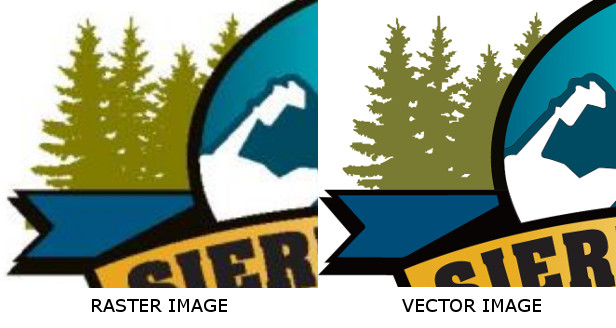Raster vs Vector Images
Summary
Raster graphic files such as .gif, .png, .jpeg, .jpg store their information as pixels in a matrix. They work well for the web, but will quickly become blurry when printed at the sizes required for your sign.
To obtain the best quality print possible, we require vector based graphic files such as .eps, .ai, .svg or .pdf. These files store information about how to actually draw the image, so they can be printed at any size required without loss of quality.

Where do I Find Vector Files?
If we have sent you an email asking for vector images chances are we've exhausted our internet resources. We're a resourceful lot but sometimes the vector files for your image or company logo are just not available in the public domain. In that case you'll need to search internally at your company for someone who has access to these files. Ask around for "vector files", or "print ready" files. If you have a media or graphics department they should have what we need. If you are a smaller company without a dedicated department, track down whoever last ordered business cards, signs or banners, as they will likely have the files.
A Detailed Explanation
Raster images are images that store information in pixels. Common file extensions for these types of files are .gif, .png, .jpeg, .jpg. These types of files are very common on the internet because they are easy to display on computer monitors which are a relatively fixed size.
In the print world though, these files don't work very well. We usually need to print your image very large and raster images just don't cut the mustard. Enter vector graphics.
Vector based image files store the information about your file in the form of paths. You can think of paths like lines and shapes that can be filled and shaded. Instead of just storing the image as a series of different colored dots, these files store information about how to actually draw the image. This allows them to be scaled to any size without loss of quality.
Common file extensions for vector images are: .eps, .ai, .svg, .pdf
Your Pdf File Might Not Be Vector Based
Pdf files can be tricky, because they can store vector based information, but they also allow raster images to be embedded into them. A raster image embedded into a pdf document is still a raster image. An embedded raster image will not have any more information about how to draw the image just because it is now inside a pdf document.
The easiest way to check to see if your pdf document contains vector or raster imagery is to open it with your pdf viewer of choice and zoom in on the image. If you can zoom into the image to 1000% (yes 3 zeros), and it still has clean lines, it is vector based. If your image gets blurry when you zoom in on it, your image is an embedded raster file.
I Can't Find Vector Files
If you just can't locate a vector based file for the image you want to use, we still have options.
Auto-Trace
We can attempt to convert your raster file to vector format using an auto tracer. This method usually works well if your raster image is a large enough file and does not contain too much detail. There is no fee for this service, so it is worth a shot.
Manual Trace
We can manually recreate your file in vector format. It won't be exact, but it will be as close as we can get it. This process may require an additional fee. Please contact us for an estimate.
Print the Raster
Printing the raster directly. Vector based files work great for things like text and logos, but some imagery just doesn't lend itself to being represented in vector format. A great example is full color photographic imagery. Photos of your plant or site are not good candidates for vectorization. In that case we can print a raster image directly, but the key for best results is a large file. When printing photographs more megabytes = better print. Depending the physical size of the printed image, you'll need a file that is at least several megabytes in size.
If you are not sure if your file can be used, shoot us an email and we'll help you out.




